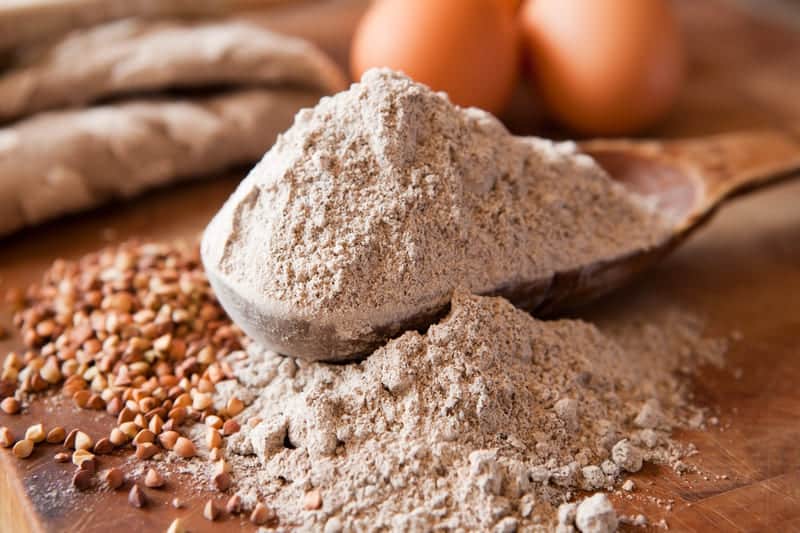Buckwheat or also known as Common Buckwheat is a pseudocereal is a good source of protein, fiber, and energy. Other than that it’s gluten-free! It’s commonly used in Asia especially in Japan, for making soba noodles.
If buckwheat is not common in your location, fret no more! You can substitute Buckwheat Flour with Wheat Flour, Potato Flour, Chickpea Flour, and Rice Flour.
It may not look like just soba noodles, you can still make noodles or pasta from these.
If you’re craving noodles or pasta and you don’t have buckwheat on hand, you may use these alternatives instead. You can make noodles from scratch using these flour substitutes.
Best Buckwheat Flour Substitutes
Stick with us because we’ll gonna show you each of the flour’s uses, and characteristics PLUS! a bonus recipe for each just for you.
1. Wheat Flour
You can pick either a soft or hard type of wheat flour. If you like it gluten-free, then you should go for the soft one. This cereal grain is a great addition to maintaining a healthy lifestyle.
It’s packed with nutrients, vitamins, and minerals needed by your body. It’s also a good source of fiber to flush out all unhealthy toxins from your body.
Other than being famous for making excellent bread and pastries, wheat flour works best when making pasta, too!
” Wheat Spaghetti Recipe”
Ingredients:
- 1 ¼ cup wheat flour
- 3 eggs
- ½ tsp salt
Instructions:
- On a flat surface, combine flour and salt.
- Make a well in the center.
- Crack the eggs and beat it with a fork while incorporating it with the mixture.
- Mix until the dough starts to form.
- Add more flour if it’s still too sticky.
- Form into a disk and rest for 30 minutes.
- Divide the dough into 8-10 parts.
- Work with each of the dough and flatten it with your hands.
- Using your dough roller, roll the dough into thin sheets.
- Dust the work surface with flour as well as the dough to prevent it from sticking.
- Cut it into ¼ inch wide strips with a knife and hang the noodles for later use.
- You may store it in the fridge for a week or 1 month in the freezer for future use.
2. Potato Flour
Another gluten-free flour on the list is potatoes. This starch is famous for its ability to crispy any fried dishes. Be it meat or vegetables, it doesn’t only add crisp to it but it also adds taste.
It’s also commonly used as a thickening agent, especially for soups and stews. Compared to other flours, potato adds flavor and body to the soup.
But aside for being excellent in making crispy dishes and thickening sauces, it’s also used by most Asian cuisines especially for making ramen noodles.
“Ramen Noodle Recipe”
Ingredients:
- 3 cups of potato starch
- 1 tsp salt
- 4 tips kansui
- 1 cup hot water
Instructions:
- Dissolve the kansui and salt in the hot water.
- Place the potato starch in the food processor and pulse it a few times.
- While the mixture’s going, add ¾ cup of the kansui mixture.
- Stop the machine to incorporate the flour by hand. Make sure you’ll get rid of the lumps.
- Knead by machine for 2-3 minutes and by hand for 2 minutes.
- Form into a disk and rest for an hour.
- Divide the dough into four parts and start working on each.
- Use a pasta machine to evenly flat the noodles. Preferably, the thickness should be 1/16 inch.
- Cut the noodles to your desired size and store in the fridge for later use.
3. Chickpea Flour
Also known as Garbanzo Bean Flour is made from ground raw chickpeas until it turns into a white flour texture. This type of flour is widely used in the Middle East, India, France, and Italy.
This vegan-friendly flour is packed with nutrients and less in calories. It has high protein content which your muscles will be happy to get. If you’re planning on doing a vegan diet, chickpea is a good superfood to add to your list.
Chickpea flour is best to use when binding ingredients such as patties, fritters, and meatballs. Its high protein content helps to mix way easier. No wonder it also works when making pasta noodles.
“Vegan Chickpea Pasta Recipe”
Ingredients:
- ¾ cups chickpea flour
- 1 ¼ cups all-purpose flour
- ¼ tsp salt
- 4 tsp olive oil
- ½ cup of warm water
Instructions:
- Stir the chickpea flour, all-purpose flour, and salt.
- Create a well on the center and add water and oil.
- Mix it well using a wooden spoon.
- Knead to form a dough ball then let it rest for about 5 minutes
- Knead for another 10 minutes until smooth in texture and cover it with a damp cloth letting it rest for 30 minutes.
- Divide the dough into two parts and run it in the pasta machine. The thickness of the noodles must be 1/16 inch.
- You may cut the pasta on your desired length, make sure you dust it with flour.
- Dry the ready-made pasta or store in the fridge for future use.
4. Rice Flour
Rice is one of the most flexible grains ever-presents. When it’s not ground, it’s perfect for rice bowls topped with stir-fried meat and vegetables.
When ground into a flour, it turns into a perfect ingredient to concoct delicious rice cake desserts. Rice pudding and mochi are one of the most favorite rice desserts by many.
Other than desserts, rice flour is also perfect for making rice noodles.
“Homemade Rice Noodles”
Ingredients:
- 1 ¼ cups rice flour
- 4 tsp cornstarch
- ½ tsp salt
- 1 tsp olive oil
- 2 ¼ cups water
Instructions:
- In a mixing bowl, add the rice flour, cornstarch salt, and water.
- Mix all the ingredients evenly.
- Add the oil then strain any liquid residue by using a fine-mesh strainer into another bowl.
- Let the dough rest for 30 minutes and cover with a damp cloth.
- Heat your wok and bring water to a boil.
- Get a flat bottom pan and brush it with oil.
- Place the pan on top of the boiling pan and add ¼ cup of the rice mixture.
- Make sure it’s evenly spread out and cover for 5 minutes.
- A noodle sheet will form into the pan, lift it and place it into an oiled cutting board.
- Cut the noodle sheets into ⅓ inch wide pieces or according to how thick you like it.
- Repeat the same steps for the remaining rice mixture.
- Store in the fridge for 7 days.
My Personal Pick
To be honest, all of the flours above are high performers in terms of substituting buckwheat flour especially for making noodles. They all have their unique characteristics and nutritional value beneficial not only for the food but for our health as well.
However, out of the four flours, two of them stood out; wheat and rice flour. But why?
First, for wheat flour, it quite resembles buckwheat in a way, especially for its light brownish color. You can actually try making soba noodles using wheat flour instead of buckwheat. If done right, there’s not much of a difference. It’s just that buckwheat noodles are chewier.
Although rice flour can’t replace buckwheat’s soba noodles, it offers its own rice noodles. It also has an interesting texture and taste. Just like soba noodles, rice noodles are chewy and flavorful.
Buckwheat flour might be irreplaceable for some. Still, it’s good to know that there are other alternatives available in the market that you can use.


